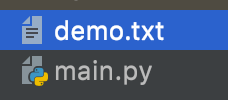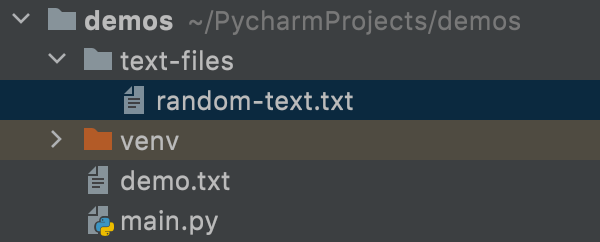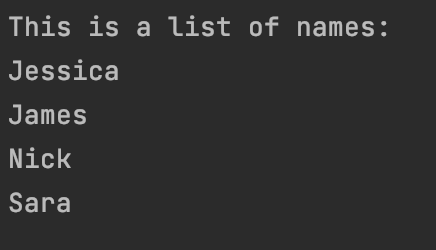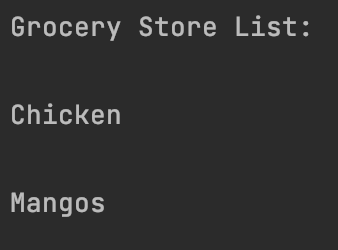How to Read the First Line of a File in Python

In Python, in that location are a few means y'all tin read a text file.
In this commodity, I will get over the open() function, the read(), readline(), readlines(), close() methods, and the with keyword.
What is the open() function in Python?
If yous want to read a text file in Python, you start take to open it.
This is the basic syntax for Python's open() office:
open("name of file you want opened", "optional fashion") File names and correct paths
If the text file and your current file are in the same directory ("folder"), and then yous can but reference the file name in the open() office.
open up("demo.txt") Here is an example of both files being in the aforementioned directory:

If your text file is in a dissimilar directory, then you will need to reference the right path proper noun for the text file.
In this example, the random-text file is inside a different folder then principal.py:

In lodge to access that file in the main.py, you have to include the folder proper noun with the name of the file.
open("text-files/random-text.txt") If yous don't have the correct path for the file, then you volition get an mistake message similar this:
open("random-text.txt") 
It is really important to proceed rail of which directory you lot are in then you can reference the correct path proper noun.
Optional Mode parameter in open up()
There are unlike modes when you are working with files. The default mode is the read mode.
The letter of the alphabet r stands for read mode.
open("demo.txt", mode="r") You can also omit mode= and just write "r".
open("demo.txt", "r") At that place are other types of modes such equally "west" for writing or "a" for appending. I am not going to go into particular for the other modes because nosotros are only going to focus on reading files.
For a complete list of the other modes, please read through the documentation.
Boosted parameters for the open up() part in Python
The open() role can have in these optional parameters.
- buffering
- encoding
- errors
- newline
- closefd
- opener
To learn more about these optional parameters, delight read through the documentation.
What is the readable() method in Python?
If y'all want to check if a file can be read, and so you can use the readable() method. This will return a True or Fake.
This example would return True because we are in the read fashion:
file = open up("demo.txt") print(file.readable()) 
If I inverse this example, to "westward" (write) fashion, and then the readable() method would render Fake:
file = open("demo.txt", "w") print(file.readable()) 
What is the read() method in Python?
The read() method is going to read all of the content of the file equally one string. This is a good method to use if you don't take a lot of content in the text file.
In this example, I am using the read() method to print out a list of names from the demo.txt file:
file = open up("demo.txt") print(file.read()) 
This method can accept in an optional parameter called size. Instead of reading the whole file, just a portion of it will be read.
If nosotros change the earlier case, we can impress out merely the starting time discussion by adding the number 4 as an argument for read().
file = open("demo.txt") impress(file.read(four)) 
If the size statement is omitted, or if the number is negative, so the whole file volition be read.
What is the close() method in Python?
Once you are done reading a file, it is of import that you lot close it. If you forget to close your file, and so that can cause problems.
This is an example of how to close the demo.txt file:
file = open("demo.txt") print(file.read()) file.close() How to employ the with keyword to close files in Python
One way to ensure that your file is closed is to employ the with keyword. This is considered good practice, because the file will close automatically instead of you lot having to manually close it.
Here is how to rewrite our example using the with keyword:
with open("demo.txt") as file: print(file.read()) What is the readline() method in Python?
This method is going to read one line from the file and return that.
In this example, we take a text file with these ii sentences:
This is the first line This is the second line If we use the readline() method, it will but impress the first sentence of the file.
with open("demo.txt") as file: print(file.readline()) 
This method also takes in the optional size parameter. We tin alter the example to add the number 7 to only read and print out This is:
with open("demo.txt") as file: print(file.readline(seven)) 
What is the readlines() method in Python?
This method will read and render a list of all of the lines in the file.
In this example, we are going to print out our grocery items as a listing using the readlines() method.
with open up("demo.txt") equally file: print(file.readlines()) 
How to use a for loop to read lines from a file in Python
An alternative to these dissimilar read methods would be to apply a for loop.
In this instance, we can print out all of the items in the demo.txt file by looping over the object.
with open("demo.txt") every bit file: for item in file: print(item) 
Determination
If y'all desire to read a text file in Python, y'all first have to open information technology.
open("name of file you want opened", "optional mode") If the text file and your current file are in the same directory ("folder"), then you tin just reference the file name in the open() function.
If your text file is in a different directory, so you lot volition need to reference the correct path proper noun for the text file.
The open up() part takes in the optional mode parameter. The default mode is the read mode.
open up("demo.txt", "r") If you lot want to check if a file can be read, then yous can use the readable() method. This will return a Truthful or Faux.
file.readable() The read() method is going to read all of the content of the file as one string.
file.read() In one case y'all are done reading a file, information technology is important that yous close it. If y'all forget to shut your file, then that can crusade issues.
file.shut() One way to ensure that your file is closed is to utilise the with keyword.
with open("demo.txt") equally file: print(file.read()) The readline() method is going to read ane line from the file and return that.
file.readline() The readlines() method will read and render a list of all of the lines in the file.
file.readlines() An culling to these different read methods would be to use a for loop.
with open("demo.txt") as file: for item in file: impress(detail) I hope you enjoyed this article and all-time of luck on your Python journey.
Larn to lawmaking for gratuitous. freeCodeCamp's open up source curriculum has helped more than than forty,000 people get jobs as developers. Get started
Source: https://www.freecodecamp.org/news/python-open-file-how-to-read-a-text-file-line-by-line/
0 Response to "How to Read the First Line of a File in Python"
Post a Comment